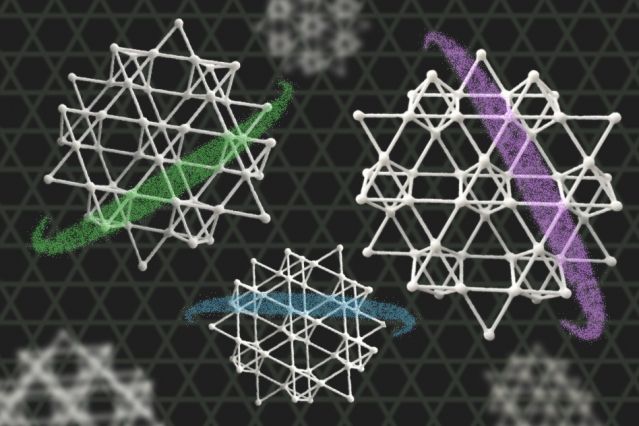
Traditional Japanese basket-weaving techniques incorporate a pattern known as kagome, which consists of interlaced, symmetrical triangles arranged in a lattice.
Physicists have been fascinated by this pattern for decades, hypothesizing that if the atoms of a metal or other conductive substance could be arranged in such a pattern, the resulting material would likely display exotic electronic properties.
Now, scientists from Massachusetts Institute of Technology (MIT), Harvard University and the Lawrence Berkeley National Laboratory have announced the creation of an exotic new material known as kagome metal—an electrically conductive crystal consisting of layers of iron and tin atoms arranged in a kagome lattice pattern. The new material is described in a study published in the journal Nature.
When the researchers passed an electric current across the atomic layers in the crystal, the current behaved in very unusual ways. Instead of the electrons in the current flowing straight through the lattice as expected, they bent into tight circular paths and flowed along the edges without losing energy.
The behavior of these electrons is similar to something known as the quantum Hall effect—a phenomenon seen in two-dimensional materials that comes under a branch of physics known as quantum mechanics.
Quantum mechanics is a fundamental theory that describes nature at the very smallest scales of atoms and subatomic particles. At such scales, objects display some very bizarre properties—for example, having the characteristics of a wave and a particle at the same time.
"By constructing the kagome network of iron, which is inherently magnetic, this exotic behavior persists to room temperature and higher," Joseph Checkelsky, co-author of the study and assistant professor of physics at MIT, said in a statement.
To make the kagome metal, the scientists ground iron and tin together and heated the resulting powder in a furnace to around 1,380 degrees Fahrenheit (750 degrees Celsius)—the point at which the iron and tin atoms crystallize and begin arranging themselves into a lattice resembling the kagome pattern. The crystals are then submerged in an ice bath, which helps the lattice patterns to remain stable at room temperature.
"The kagome pattern has big empty spaces that might be easy to weave by hand but are often unstable in crystalline solids, which prefer the best packing of atoms," said Linda Ye, co-author of the study and also from MIT. "The trick here was to fill these voids with a second type of atom in a structure that was at least stable at high temperatures. Realizing these quantum materials doesn't need alchemy, but instead materials science and patience."
Due to its unique electrical properties, the researchers are now investigating ways to produce other forms of the kagome lattice that could be used to create devices with perfect electricity conduction that don't lose any energy, such as "dissipation-less" power lines and super-fast electronic circuits.
To that end, the new technology could also have applications in the field of quantum computing, according to Checkelsky. Should they ever be built, large-scale quantum computers would theoretically be able to solve certain problems that even the most powerful classical computers struggle to calculate, revolutionizing fields ranging from machine-learning to medicine and climate science, among many others.
Uncommon Knowledge
Newsweek is committed to challenging conventional wisdom and finding connections in the search for common ground.
Newsweek is committed to challenging conventional wisdom and finding connections in the search for common ground.
About the writer
Aristos is a Newsweek science reporter with the London, U.K., bureau. He reports on science and health topics, including; animal, ... Read more
To read how Newsweek uses AI as a newsroom tool, Click here.








